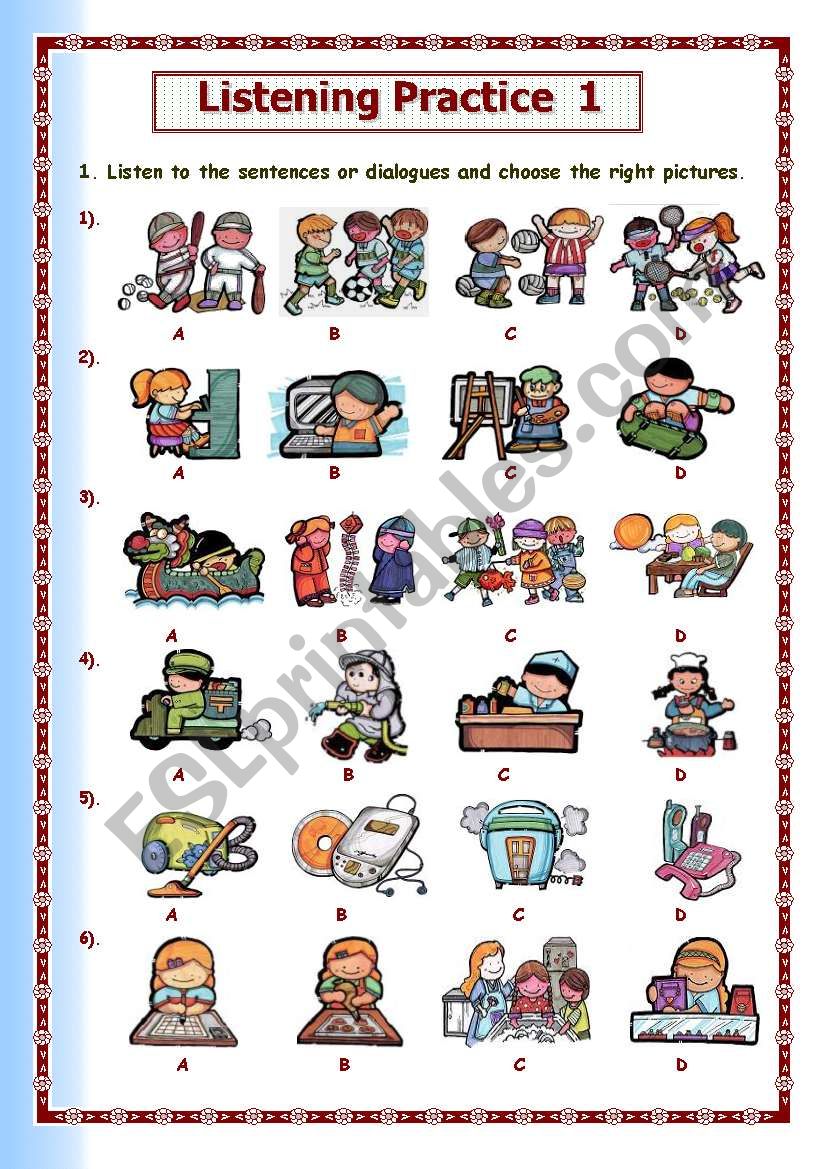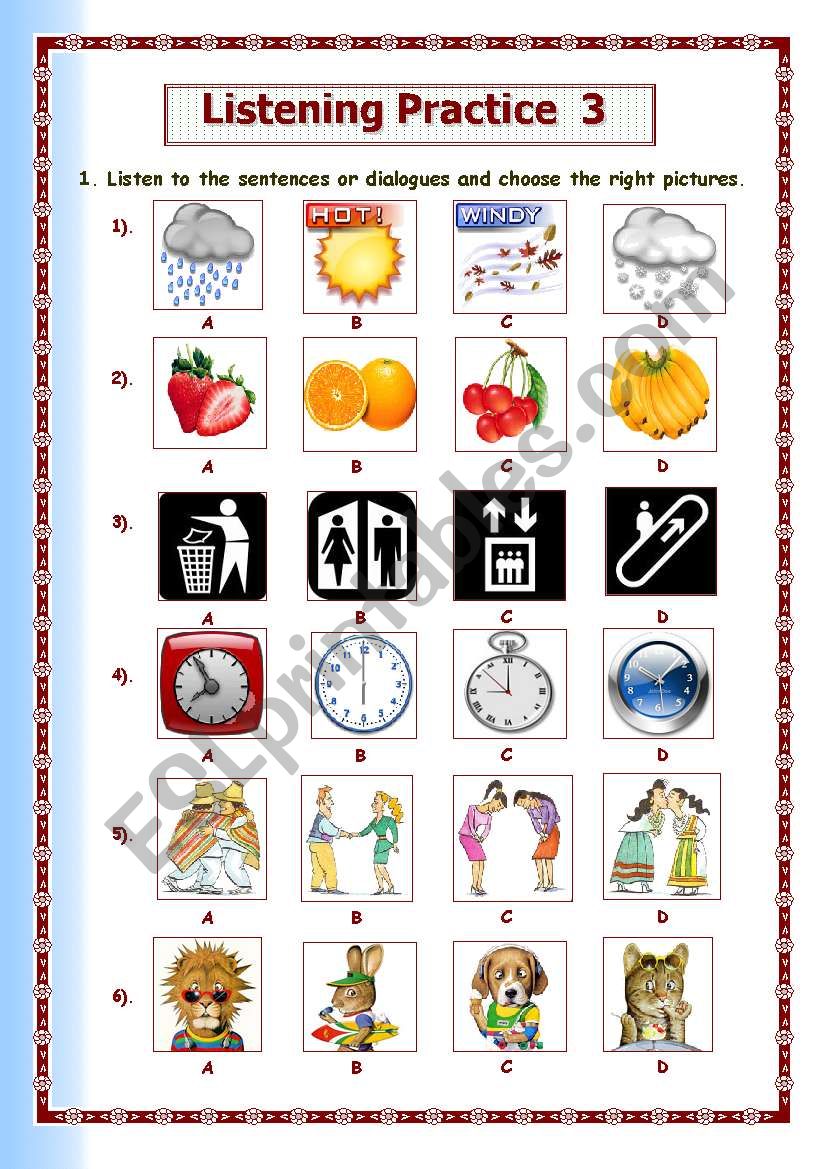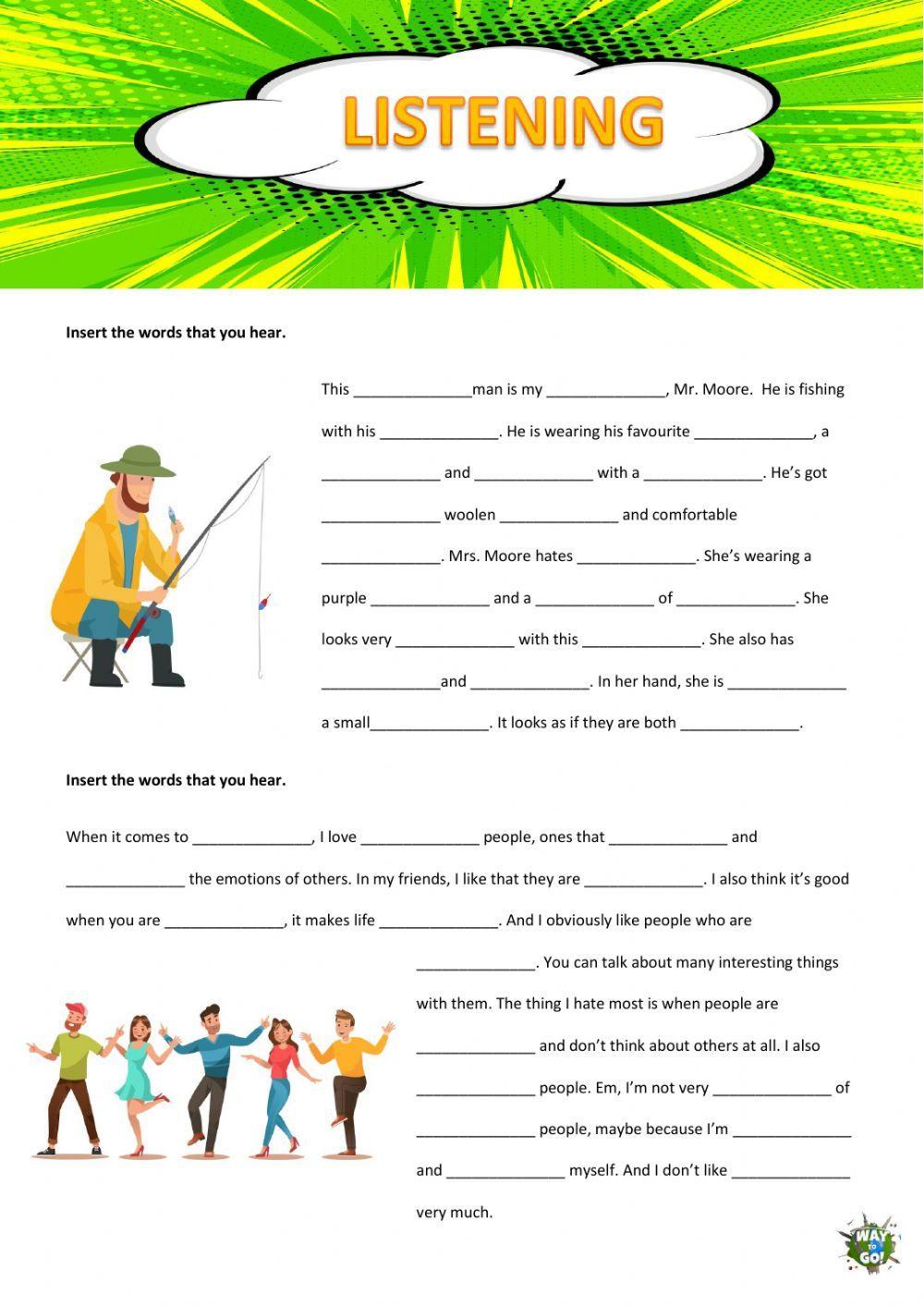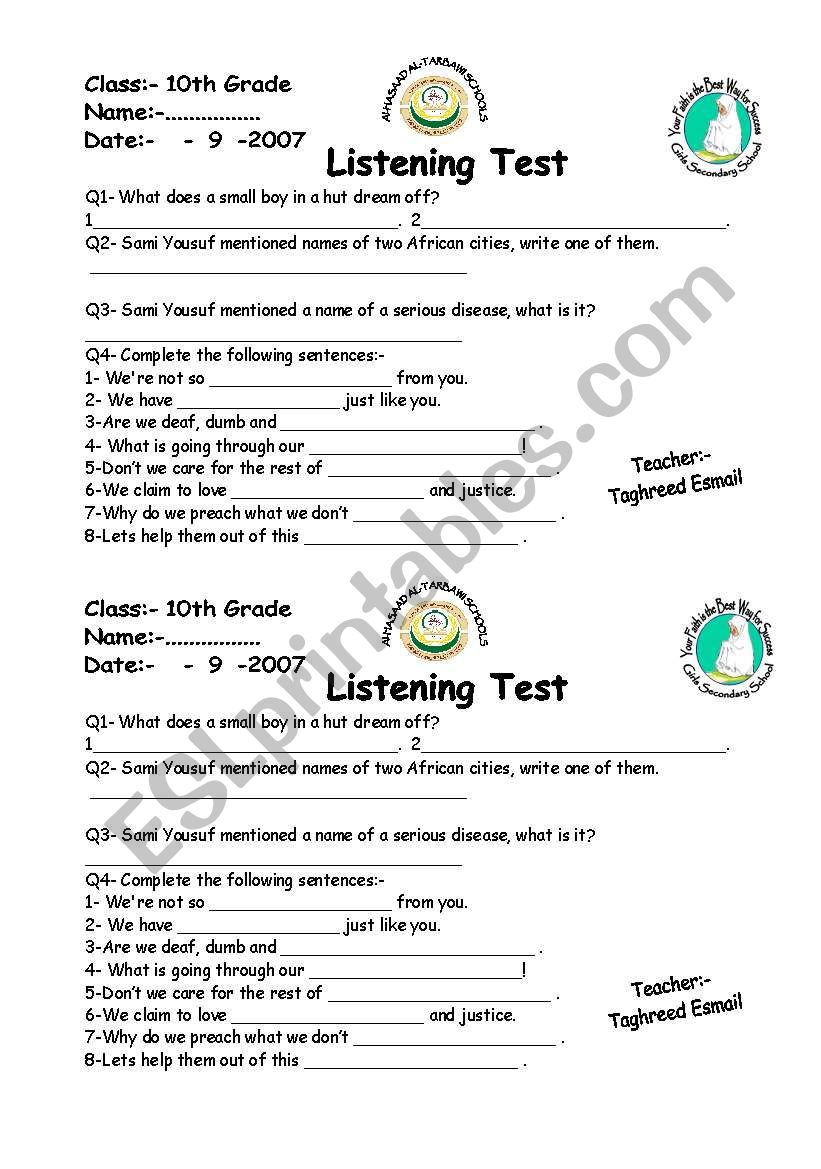
Beyond the Ear: Engaging Intermediate ESL Learners with Dynamic Listening Activities
For intermediate English as a Second Language (ESL) learners, the journey from basic comprehension to nuanced understanding can often feel like navigating a complex maze. They’ve mastered foundational grammar and vocabulary, but truly grasping spoken English—with its varied accents, speeds, and idiomatic expressions—presents a unique set of challenges. This is where well-designed listening activities with audio for intermediate ESL worksheets become indispensable. They serve as a crucial bridge, helping learners not just hear words, but actively process, interpret, and respond to spoken language, moving them closer to fluency and real-world communication.
Why Intermediate Listening Needs a Specific Focus
At the intermediate level, learners are past the initial hurdles of survival English. They can understand simple commands and basic conversations. However, they often struggle with:

- Speed and natural speech: Real conversations are fast, often slurred, and contain hesitations and fillers.
- Accents and dialects: Exposure is usually limited to one or two accents, making others difficult to decode.
- Idioms, phrasal verbs, and slang: These common elements of native speech can be baffling without context.
- Inference and implied meaning: Understanding sarcasm, irony, or the speaker’s true intention requires higher-level cognitive skills.
- Sustained listening: Maintaining focus over longer audio passages (e.g., news reports, lectures, podcasts).




Effective listening activities with audio for intermediate ESL worksheets are specifically tailored to address these challenges, providing structured practice that builds confidence and competence.
Core Principles for Designing Effective Listening Activities

Before diving into specific activity types, it’s vital to understand the underlying principles that make listening practice truly effective:
- Authenticity: Whenever possible, use authentic audio materials (news clips, interviews, podcasts, movie trailers, songs). This exposes learners to real-world language use.
- Variety: Mix up activity types to maintain engagement and target different listening sub-skills. Repetition of the same format can lead to boredom.
- Scaffolding: Always provide pre-listening, while-listening, and post-listening tasks. This scaffolding reduces anxiety, prepares learners for the content, and allows for deeper processing.
- Purposeful Listening: Learners should always have a clear reason to listen. Is it for specific details, the main idea, or the speaker’s opinion? This helps them focus.
- Relevance and Interest: Choose topics that are engaging and relevant to the learners’ lives or interests. This boosts motivation significantly.
- Manageable Challenge: The audio should be challenging but not overwhelming. If it’s too difficult, learners will become frustrated; too easy, and they won’t grow.



Diverse Listening Activities with Audio for Intermediate ESL Worksheets
Here’s a comprehensive look at various dynamic listening activities, complete with ideas for how they can be integrated into intermediate ESL worksheets.
I. Comprehension and Detail Extraction Activities
These activities focus on understanding the explicit information presented in the audio.
-
Gap-Fill/Cloze Exercises:
- Description: Learners listen to an audio passage (dialogue, song, short monologue) and fill in missing words or phrases on a worksheet.
- Intermediate Focus: Move beyond simple vocabulary to include phrasal verbs, collocations, or short idiomatic expressions. Use audio with natural pauses or slightly faster speech.
- Worksheet Integration: Provide a transcript with strategic blanks. Include a word bank for added support, or challenge learners to complete it purely from listening.
- Audio Source Ideas: Song lyrics, short news reports, simple recipes, weather forecasts.
-
True/False or Multiple Choice Questions:
- Description: After listening to an audio segment, learners answer T/F or MCQs based on the content.
- Intermediate Focus: Questions should require more than surface-level understanding. Include distractors that are plausible but incorrect, requiring careful listening for detail or nuance. Questions could relate to opinions, sequence of events, or implied facts.
- Worksheet Integration: List clear T/F statements or MCQs. Provide space for learners to justify their answers or correct false statements.
- Audio Source Ideas: Short interviews, radio advertisements, public announcements, documentary snippets.
-
Specific Information Search (Jigsaw Listening):
- Description: Learners are given a specific piece of information to listen for (e.g., names, dates, numbers, specific facts). In a jigsaw activity, different groups listen for different pieces of information and then share.
- Intermediate Focus: The information might be embedded within a longer, more complex audio, requiring learners to filter out irrelevant details.
- Worksheet Integration: Create a table or checklist on the worksheet for learners to fill in the specific information they hear. For jigsaw, provide each group with a unique set of target information.
- Audio Source Ideas: Travel itineraries, news summaries, historical accounts, short biographical sketches.
-
Note-Taking and Outlining:
- Description: Learners listen to a longer audio (e.g., a mini-lecture, a podcast segment, a presentation) and take notes, focusing on main ideas and key supporting details.
- Intermediate Focus: Teach different note-taking strategies (e.g., Cornell notes, mind mapping, outlining). The audio should have a clear structure but contain sufficient detail to challenge note-takers.
- Worksheet Integration: Provide a structured note-taking template on the worksheet, or simply blank space with clear instructions. Follow up with questions that require learners to use their notes.
- Audio Source Ideas: TED-Ed talks (simplified versions), educational podcasts, simplified news analyses.
II. Inference and Critical Thinking Activities
These activities push learners beyond literal comprehension to infer meaning, identify tone, and understand implicit messages.
-
Predicting Outcomes/Completing Stories:
- Description: Play part of a story or dialogue and pause. Learners predict what will happen next or how the conversation will end. Then, they listen to verify their predictions.
- Intermediate Focus: Encourage learners to justify their predictions based on contextual clues, speaker’s tone, or cultural understanding implied in the audio.
- Worksheet Integration: On the worksheet, provide prompts like "What do you think happens next?" or "How will the character react?" Include space for initial predictions and a section for confirming or correcting after listening.
- Audio Source Ideas: Short narrative stories, dramatic dialogues, excerpts from audiobooks.
-
Identifying Speaker’s Mood/Tone/Purpose:
- Description: Learners listen to short audio clips and determine the speaker’s emotional state, attitude, or underlying purpose (e.g., angry, sarcastic, excited, persuasive, informative).
- Intermediate Focus: Focus on intonation, stress, pauses, and word choice as clues. Discuss how these non-verbal cues contribute to meaning.
- Worksheet Integration: Provide a list of moods/tones/purposes for learners to choose from, or ask them to describe what they infer. Include questions like "What specific words or sounds helped you decide?"
- Audio Source Ideas: Short dialogues with varying emotional content, excerpts from movies/TV shows, voice messages.
-
Inferring Context and Relationships:
- Description: Play a conversation without revealing the speakers’ relationship or the setting. Learners infer these details based on the dialogue.
- Intermediate Focus: Requires careful attention to vocabulary, tone, and conversational patterns. Learners must "read between the lines."
- Worksheet Integration: Prompts on the worksheet could be "Who are these people? What is their relationship?" "Where are they?" "What are they doing?" Encourage learners to list specific phrases or words that support their inferences.
- Audio Source Ideas: Unseen conversations from daily life (e.g., at a café, in an office, a family discussion).
-
Summarizing and Paraphrasing:
- Description: Learners listen to a short monologue or discussion and then summarize the main points in their own words or paraphrase specific sections.
- Intermediate Focus: This requires synthesizing information and rephrasing it accurately, demonstrating a deep level of understanding.
- Worksheet Integration: Provide space for a short summary or specific questions asking for paraphrased information. You might also provide sentence starters.
- Audio Source Ideas: Short news segments, opinions pieces, podcast excerpts.
III. Interactive and Productive Listening Activities
These activities integrate listening with speaking, writing, or other skills, making the learning process more dynamic and collaborative.
-
Role-Playing Based on Audio Scripts:
- Description: Learners listen to a dialogue, analyze it, and then adapt or extend it through role-play.
- Intermediate Focus: They can practice pronunciation, intonation, and conversational flow. The audio provides a model, but learners must apply it creatively.
- Worksheet Integration: Provide the audio script with sections to be adapted or extended. Include prompts for creating new lines or scenarios based on the original audio.
- Audio Source Ideas: Everyday conversations, customer service interactions, short interview segments.
-
Discussion Prompts from Audio:
- Description: Learners listen to an audio piece (e.g., a debate, a persuasive speech, an opinion piece) and then discuss the content, express their own opinions, or respond to specific questions.
- Intermediate Focus: This moves beyond comprehension to critical engagement with the content. It integrates listening with speaking and critical thinking.
- Worksheet Integration: List open-ended discussion questions based on the audio. Learners can prepare notes on the worksheet before discussing.
- Audio Source Ideas: Short segments from debates, opinion podcasts, documentary voice-overs.
-
Dictation and Dictogloss:
- Description:
- Dictation: Learners write down exactly what they hear.
- Dictogloss: Learners listen to a short text several times, taking notes, then collaboratively reconstruct the text as accurately as possible, focusing on meaning over exact wording.
- Intermediate Focus: Dictation refines attention to detail, spelling, and grammar. Dictogloss enhances collaborative listening, negotiation of meaning, and grammatical accuracy in reconstruction.
- Worksheet Integration: For dictation, simply provide numbered lines. For dictogloss, provide space for initial notes and then a larger space for the reconstructed text.
- Audio Source Ideas: Short descriptive passages, news headlines, proverbs, famous quotes.
- Description:
-
Listen and Draw/Map:
- Description: Learners listen to descriptions (e.g., of a person, a place, directions) and draw what they hear or map a route.
- Intermediate Focus: Develops detailed comprehension of spatial prepositions, adjectives, and sequential instructions.
- Worksheet Integration: Provide a blank grid for drawing or a simple map outline for marking routes.
- Audio Source Ideas: Tourist descriptions, instructions for a treasure hunt, character descriptions.
Designing Effective Worksheets for Listening Activities with Audio for Intermediate ESL Worksheets
The worksheet is the tangible component that guides the learner through the listening process. A well-designed worksheet should:
-
Pre-listening Tasks:
- Vocabulary Preview: Introduce key words or phrases that might be challenging.
- Prediction: Ask learners to predict the topic, content, or outcome based on the title, images, or initial sounds.
- Background Activation: Prompt questions to activate prior knowledge related to the topic.
- Worksheet Example: "Before you listen, look at the picture. What do you think this audio is about? List 3 words you expect to hear."
-
While-listening Tasks:
- Clear Instructions: Ensure tasks are straightforward and directly related to the listening purpose.
- Varying Difficulty: Offer a mix of easy (main idea) and more challenging (specific detail, inference) questions.
- Multiple Passes: Design tasks that can be done over several listens (e.g., first listen for main idea, second for details).
- Worksheet Example: "Listen once for the main idea. Circle the best summary. Listen again. Answer questions 1-5. Listen a third time to check your answers and fill in the blanks."
-
Post-listening Tasks:
- Comprehension Check: Review answers, clarify misunderstandings.
- Discussion: Engage learners in conversations about the audio’s content, their opinions, or related experiences.
- Extension Activities: Integrate with other skills – writing a summary, role-playing a similar scenario, researching a related topic.
- Worksheet Example: "Discuss with a partner: Do you agree with the speaker’s opinion? Why/Why not? Write a short paragraph summarizing the key points of the audio."
Tips for Teachers and Learners
For Teachers:
- Choose Wisely: Select audio materials that are appropriate for the intermediate level – not too fast, not too complex in vocabulary, but still authentic.
- Be Patient: Listening takes time and repeated exposure. Don’t expect perfection after one listen.
- Provide Support: Transcripts can be incredibly helpful for checking understanding after the activity.
- Create a Safe Environment: Encourage guessing from context and making mistakes. Emphasize that it’s okay not to understand every single word.
- Integrate Skills: Connect listening activities with speaking, reading, and writing to reinforce learning.
For Learners:
- Don’t Panic: It’s natural not to understand everything. Focus on the main ideas first.
- Listen Actively: Have a purpose in mind before you start listening.
- Guess from Context: Use the words you do understand, as well as the situation, to infer the meaning of unfamiliar words.
- Use Resources: If available, use transcripts to check your understanding after listening.
- Practice Regularly: Listen to English every day, even if it’s just for a few minutes. Podcasts, news, songs, and YouTube videos are excellent resources.
- Make it Fun: Choose topics and audio materials that genuinely interest you.
Conclusion
Mastering listening comprehension is arguably one of the most challenging yet rewarding aspects of learning English. For intermediate ESL learners, it’s the key to unlocking true fluency and confident communication in the real world. By consistently engaging with diverse listening activities with audio for intermediate ESL worksheets, educators can provide the structured, engaging, and challenging practice necessary for learners to bridge the gap between classroom English and authentic spoken language. These carefully crafted activities not only enhance auditory skills but also build confidence, foster critical thinking, and pave the way for learners to become proficient and independent English speakers. The investment in dynamic and varied listening activities with audio for intermediate ESL worksheets is an investment in the learner’s complete linguistic development.
